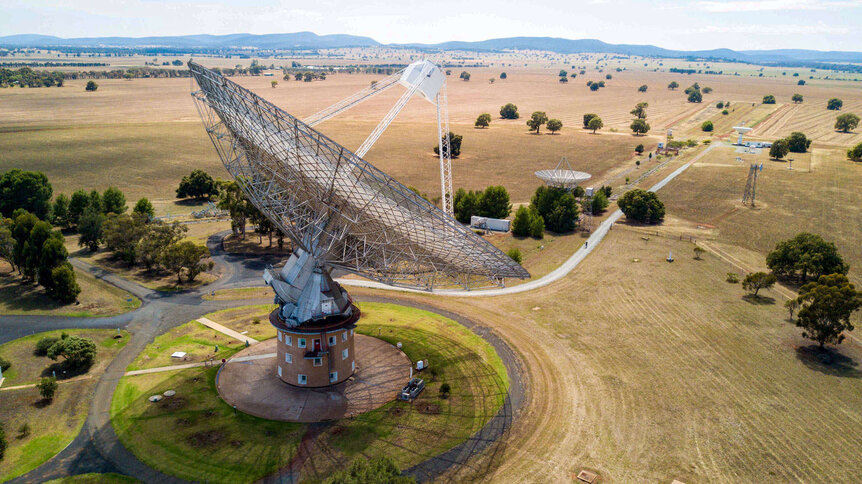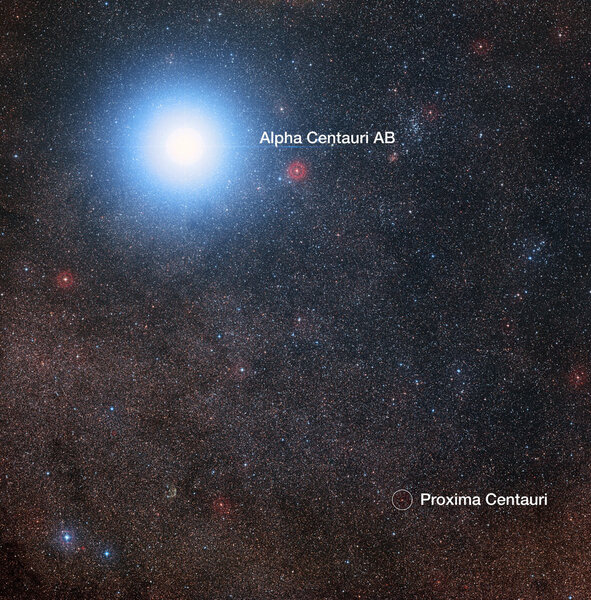Create a free profile to get unlimited access to exclusive videos, sweepstakes, and more!
A signal from Proxima? Likely intelligent, unlikely from aliens

Astronomers looking for signs of alien life on other planets in the galaxy have found an unusual signal from Proxima Centauri, the nearest star to the Sun, that is... intriguing. It was just a single detection that came and went, but it does have some characteristics you'd expect from an intelligent source. The problem is, as it always is, that source may be us.
I want to be very clear here right off the bat, because The Internet: This is by no means proof that aliens are out there, or even (yet) good evidence of it. I'll explain the science of what was seen, but at the moment, the default assumption is that this is a human-made signal until shown otherwise.
In other words:
I'll also note that the news of this was leaked to the newspaper The Guardian, and it's now being reported by various venues (my colleague Nadia Drake has an excellent overview at National Geographic, for example, and Scientific American also has a good synopsis). The work on analysis has not yet been published in the scientific journals, though papers are expected to come out soon, so we don't have the whole story yet. I am in general reluctant to report on non-published data, but given that this news is out there, I think it's important to give people the background.
The signal was detected as part of a set of observations of the star Proxima Centauri (usually just called Proxima) in the summer of 2019. It was being done as part of Breakthrough Listen, an initiative to observe the nearest one million stars to our Sun using radio telescopes across the world to look for signals of alien intelligence.
In this case, Proxima was being observed using the venerable Parkes radio telescope in Australia. Proxima is a red dwarf, a small, cool star so faint that even though it's the closest star to the Sun, just a hair over 4.2 light years away (about 42 trillion kilometers), it's not visible to the naked eye. You need a decent telescope to see it at all. It's part of a triple system, orbiting the binary star Alpha Centauri.
Proxima is a flare star, erupting in powerful explosions on its surface like our own Sun's solar flares, and that's why it was being observed. An undergraduate student going over the observations some time later noticed that there was a spike in energy at a very specific frequency, 982.002 MHz. That's pretty weird; stars usually emit light in a broad range of frequencies. Some natural processes do emit light in a relatively narrow range, but in this case the range was so narrow it was difficult to explain.
A standard radio astronomy technique to make sure that what you see is coming from the object you're observing is to move the telescope back and forth a bit to point to a different part of the sky and see if the signal persists (perhaps leaking into the dish from a source nearby); this is called “nodding” because it's like a head nodding. When they did this, the signal went away, then came back when they repointed at Proxima.
So it appears to be coming from the star, or at least form very nearby it in the sky. It also appears to have a very narrow frequency range. Not only that, but another characteristic you might expect from an intelligent signal is that, over time, the frequency itself will shift a bit — if aliens are transmitting from a planetary surface, as that planet rotates it causes a Doppler shift in the signal. A shift was seen in the signal, which is interesting.
So. Aliens?
Well, that's a huge leap from here. The basic problem here is that astronomers are looking for a signal from intelligence, and they're swamped in signals from intelligence: Us. Phone carriers, satellites, military communications... these all use various frequencies of radio to talk to each other, and that's creating vast amounts of noise that look just like the sort of signal you're trying to detect. There have been countless times interesting signals have been detected which only turned out to be coming from humans (one of the more famous stories was from a signal detected by the very same Parkes dish, which turned out to be people opening the door to the microwave in the observatory kitchen before the oven had stopped, flooding the dish with microwave signals).
So there are a long list of tests the signal has to pass to be considered a viable candidate for alien intelligence. This one has only passed the first few.
But I'll admit I'm scratching my head. This signal's frequency isn't one generally used by satellites and such. And Proxima is located deep in the southern sky, pretty far from the kinds of orbits you'd expect of satellites that could emit such a signal (though not impossible; two astronomer friends of mine have been speculating over this on Twitter in fact). A slowly moving Earth satellite that happened to be near Proxima in the sky at the time could emit a signal with a shift in frequency, but we'll have to wait and see if the scientists looked into the specifics of that.
And what of Proxima? It has at least two planets, called Proxima b and c. The first planet, b, was discovered in 2016, and is likely to be roughly the same size as Earth. It also orbits the star close enough that its temperature might be in the right range for life. Planet c is farther out, and therefore very cold, a frozen ball.
Right now, though, we don't know much about Proxima b at all. Worse, as I mentioned, Proxima is a flare star, which means it floods its planetary system with high-energy ultraviolet and X-ray light. Over billions of years that can strip away a planet's atmosphere, or just create conditions not conducive for life. A lot of papers have come out in the past couple of years on this topic, but it's not clear exactly what the effects are.
Still, it's not ludicrous to wonder if b might sustain life. But send us signals?
I have problems with that. First of all, the very fact that it's the closest star to the Sun makes this seem so very very unlikely. What are the odds? Extremely low, unless life is everywhere, and if that were true it seems like it would be easier to spot.
Also, the signal is just a single frequency, like a single tone, with no information encoded in it. A radio signal from, say, a radio station encodes information (the sounds you hear when you tune a radio to the station) by modulating the signal, changing characteristics of it like its amplitude or frequency. None of that is seen here, making it even less likely, to me, to be a signal from aliens.
And again, every time there has been a signal like this (with the exception of the WOW! Signal, which is still something of a mystery) it has turned out to be from something other than aliens, either a natural phenomenon (the first pulsar signal ever discovered was actually nicknamed LGM-1, for Little Green Men!) or from human tech.
I strongly suspect this is the latter. We just don't know yet. My advice: Don't let your imagination run away. From what we know so far this is interesting, but nowhere near conclusive. We'll have to wait for the analysis to continue and the papers to be published. Patience.
Correction (Dec. 20, 2020): I originally wrote that Shane Smith, who found the signal, is a graduate student. He is actualy an undergraduate student at Hillsdale College in Michigan.































